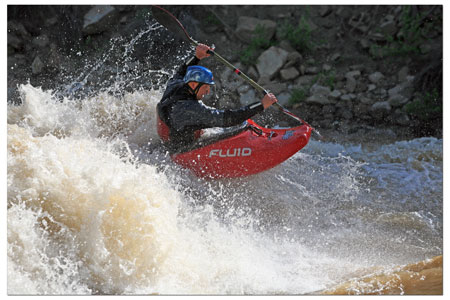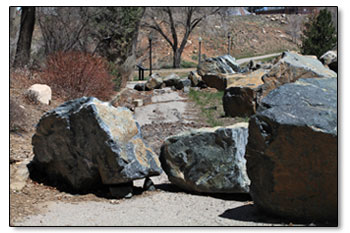 |
|
Mike Karpel surfs it up in Corner Pocket last season. One of the things the Whitewater Park design team plans to address is the natural erosion that occurs on the river right side of the bank between Smelter and Corner Pocket./Photo by Steve Eginoire
|
Rock solid
City slates Whitewater Park work for late 2013
by Tracy Chamberlin
It’s happening. Really. Construction on the city’s Whitewater Park is going to take place late in 2013, according to city officials, members of the design team and the Animas River Task Force.
It’s happening. Really. Construction on the city’s Whitewater Park is going to take place late in 2013, according to city officials, members of the design team and the Animas River Task Force.
“It’s been a long time coming,” said John Brennan, a member of the task force, consultant to the city on the Whitewater Park and Durango Whitewater coach.
It all begins at 5 p.m. Monday at the Durango Rec Center when the city plans to introduce the public to the park’s design team, reveal the plan for improving the existing park and what people can expect during construction.
|
|
Heading up the design team is Scott Shipley, president of S2o Design and Engineering.
The three-time Olympic veteran and holder of four kayak world titles has been paddling the Animas River for more than 20 years, winning his first international medal here when he was just 19 years old.
According to Parks and Recreation Director Cathy Metz, he was also involved in helping the city obtain the water rights key to developing the Whitewater Park that sits right next to the city’s most popular park, Santa Rita. “I think we have the best designer possible,” she said.
Shipley’s no stranger to top-notch course construction. His company designed the whitewater course for the London Olympics last summer and is also the brains behind the course for the 2016 Games in Rio de Janeiro.
Originally built in the 1980s, Durango’s Whitewater Park was the first of its size and scale in the U.S. and a mecca for paddlers from around the world.
As nature slowly eroded away some of the park’s features, namely Smelter Rapid, it lost some of its fame. “It’s such an iconic part of the river,” Brennan said. “It’s going to be nice to bring people back to Durango to enjoy it.”
The project is about improving the existing park, not creating an entirely new one. For Shipley, that’s the interesting thing about it.
He said many of the park’s features were created years ago, and over time they’ve evolved and been tuned by the local paddling community.
Some of the drop structures, like Smelter or Corner Pocket, have eroded due to powerful flows. “For these key structures,” he said, “our objectives are to stabilize the preferred geometry and preserve the drops that folks enjoy there.”
The real functional improvements, though, will be in the lower part of the course. Shipley said one of the concepts, which came from the public process used to develop the park’s plan, was a desire to create beginner and intermediate features in that lower section.
“I am most excited to bring these aspects,” he added.
Shipley said one substantial navigational improvement is that they’ll make the river left “sneak” channel on Smelter easier to navigate during high flows, allowing paddlers to bypass the big drop.
The design team also plans to address the natural erosion that occurs on the river right side of the bank between Smelter and Corner Pocket. They’ll make a slight change in the geometry of the main drop, “so the pressure will not be so concentrated on that right shore line at higher flows.”
The Monday meeting is not just an opportunity for residents to meet the design team and find out about the final product. It’s also meant to let them know what to expect during the construction process.
After all, this is no small project.
 |
| The large boulders strewn about the river trail at the Whitewater Park will at last get put to use later this year./Photo by Steve Eginoire |
During the winter season, snowfall and all, construction involves dewatering the river with the use of berms, cofferdams and sump pumps; and, they’ll be using boulders and concrete to shore up some of the features.
The concrete won’t be readily visible to boaters, fisherman and others river users. “It’s going to be done with the utmost respect,” Brennan said.
The first step, though, is to search for a contractor. The city is looking to hire someone this summer and could potentially start prep work this fall. But, the real construction is slated for the winter.
The critical in-stream development needs to happen when river flows are lowest. Once they’ve dropped significantly and there’s no risk of a surge, the work will begin. The process is expected to last about three to four months, making the park paddle ready for spring 2014.
Like any ongoing saga, the end of construction doesn’t mean an end of the story. The rise and fall of the river can make permanence difficult. It can get as low as 100 cubic feet per second, or cfs, and as high as 8,000 cfs, according to Brennan.
The park and its features will need continued maintenance, particularly in the first few years. As the water moves down the Animas, it won’t stop shaping and shifting everything it touches. However, the method planned for the project, called dry stack construction, should make maintaining the park’s features easier.
The city also plans to improve the facilities and river trail between Santa Rita Park and the river; however, this won’t happen until after the in-stream construction is complete.
The bottom line for the Whitewater Park project is $1.26 million. The bulk of that budget comes from the Open Space, Parks and Trails fund.
The rest stems from a combination of local contributors: Durango Whitewater, Southwestern Water Conservation District, Trout Unlimited Five Rivers Chapter and Commercial River Outfitters, among others.
City officials applied twice for grants from Great Outdoors Colorado, which uses a portion of lottery proceeds to support the state’s parks, trails and open space. Unfortunately for the city, they weren’t awarded either grant.
The biggest hurdle for the city, though, wasn’t the money. It was obtaining the recreational in-channel diversion water rights for boating on the Animas. Known as the RICD, these rights protect the park from possible future diversions upstream.
They also come with a laundry list of parameters and permit particulars, and the only way to hold onto those rights is to make the in-stream improvements at the Whitewater Park.
Obtaining these rights and associated permits has at times put the project into a holding pattern. But this time, according to those involved, it’s really happening.
In this week's issue...
- January 25, 2024
- Bagging it
State plastic bag ban is in full effect, but enforcement varies
- January 26, 2024
- Paper chase
The Sneer is back – and no we’re not talking about Billy Idol’s comeback tour.
- January 11, 2024
- High and dry
New state climate report projects continued warming, declining streamflows
